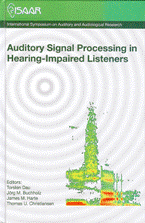Evaluation of a Danish speech corpus for assessment of spatial unmasking
Resumé
This paper reports on an evaluation of a new Danish speech corpus for assessment of spatial unmasking. The structure of the sentences used (Example “Michael had seven yellow boxes”), lends itself to be used in a multitalker speech intelligibility task with selective attention, by using the leading name as a call sign. In experiment 1 the speech material was evaluated for speech recognition homogeneity of the compiled test lists. The evaluation was carried out using 9 normal hearing native Danish speaking subjects, who listened to and repeated sentences from a female target talker presented against a background of two concurrent female talkers. All sound was presented from a single loudspeaker. Data analysis, carried out on group data, revealed systematic differences in speech intelligibility, which could be related to target call sign and target talker. Based on the analysis, the selection of the speech material to use in future studies was limited to reduce spread in speech intelligibility. Training effects were observed, but they were of small magnitude. In experiment 2 the speech material selected in experiment 1 was used for assessing spatial unmasking in a group of 9 normal hearing native Danish speaking subjects. Target sentences were always played from directly in front of the subject. Spatial unmasking was assessed in two unmasked conditions, offering different sets of spatial cues. The first condition elicited unmasking along the median plane by playing maskers from one speaker directly behind the subject. The benefit obtained by subjects was about 10 dB on average, but varied considerably. In the second unmasked condition, maskers were played from two speakers placed +/- 50 degrees to the left and right of the target. The benefit obtained by subjects was much more consistent than in the first condition, with an average effect of about 14 dB.
Referencer
Brungart, D. S., Simpson, B. D., Ericson, M. A., and Kimberly, R. S. (2001). “Informational and energetic masking effects in the perception of multiple simultaneous talkers,” J. Acoust. Soc. Am., 110, No. 5
Helfer, K. S., and Freyman, R. L. (2006). “How do task instructions in uence speech- on-speech masking?,” Poster presented at 151st Meeting of the Acoust. Soc. Am.
Neher, T., Behrens, T., Kragelund, L., and Petersen, A.S. (2007). “Spatial Unmasking in Aided Hearing-Impaired Listeners and the Need for Training.” Proceedings of the International Symposium on Audiological and Auditory Research, Helsingør, Denmark, Aug. 29-31.
Marrone, N. L., Mason, C. R., and Kidd, G.Jr. (2007). “Spatial Release from Mask- ing; Hearing Loss, Age and Reverberation Effects,” Poster presented at Am. Aud. Soc. Meeting, Phoenix, NM
McArdle, R. A., and Wilson, R. H., (2006). “Homogeneity of the 18 QuickSIN Lists,” J. Am. Acad. Audiol., 17, No. 3
Middlebrooks, J.C., and Green, D.M. (1991). “Sound localization by human listeners,” Ann. Rev. Psychol., 42, 135-159.
Ortiz, J. A., and Wright, B.A. (2005). “Effects of different amounts of brief training and rest on the generalization of learning from interaural-level-difference to inter- aural-time-difference discrimination,” J. Acoust. Soc. Am., 117, 2561.
Sweetow, R. and Palmer, C. V. (2005). “Efficacy of individual auditory training in adults: A systematic review of the evidence,” J. Am. Acad. Audiol., 16, 494-504.
“Design, Optimization and Evaluation of a Danish Sentence Test in Noise,” Int. J. Audiol., 42, No.1.
Yderligere filer
Publiceret
Citation/Eksport
Nummer
Sektion
Licens
Authors who publish with this journal agree to the following terms:
a. Authors retain copyright* and grant the journal right of first publication with the work simultaneously licensed under a Creative Commons Attribution License that allows others to share the work with an acknowledgement of the work's authorship and initial publication in this journal.
b. Authors are able to enter into separate, additional contractual arrangements for the non-exclusive distribution of the journal's published version of the work (e.g., post it to an institutional repository or publish it in a book), with an acknowledgement of its initial publication in this journal.
c. Authors are permitted and encouraged to post their work online (e.g., in institutional repositories or on their website) prior to and during the submission process, as it can lead to productive exchanges, as well as earlier and greater citation of published work (See The Effect of Open Access).
*From the 2017 issue onward. The Danavox Jubilee Foundation owns the copyright of all articles published in the 1969-2015 issues. However, authors are still allowed to share the work with an acknowledgement of the work's authorship and initial publication in this journal.


